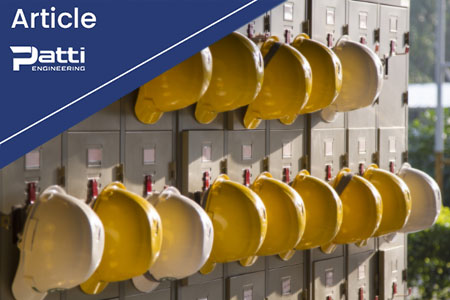
6 Safety Tips Every New Engineer Should Know
Engineering Safety Topics
- Pay Attention to Safety Training
- PPE (Personal Protective Equipment)
- Clothing
- Pack the Basics
- Know Your Surroundings
- Self-Care
Manufacturing and industrial facilities are filled with a wide range of dangerous safety risks. The work environments can be fast paced, have many moving parts, and contain very complex processes. The dangers may be obvious and out in the open. But the dangers could be hidden from view and difficult to recognize. As a new engineer, it can be easy to overlook the less than obvious dangers that can result in serious injury or even death. The following are some general safety tips that every new engineer should know.
Pay Attention to Safety Training
A responsible workplace will require a new engineer to go through some sort of work relevant safety training. The training may be delivered through an in-person program, through a series of videos, or a hybrid of both. One should pay careful attention and should take notes for future reference. While a lot of safety training may seem like common sense, one never knows what one may forget over time. When confronted with an unfamiliar workplace situation in which one feels undertrained or uncomfortable to work in, one should reach out to their manager or HR and ask for resources for the necessary safety training.
PPE (Personal Protective Equipment)
In this job, engineers will be exposed to a variety of manufacturing processes and machines. When working on-site at a customer’s facility, at the bare minimum one should always have ANSI Z87.1 certified safety glasses on and wear comfortable, closed-toe shoes. Some customers may have different safety requirements, which one should check before going on site. Other PPE to consider having available includes but is not limited to, steel-toed boots, safety gloves, hard hat, and reflective vests. Some facilities may require special PPE suitable for the particular hazards in those facilities. Some facilities may have specific foot protection requirements. While nearly all facilities will require closed-toe shoes, some may require ASTM compliant steel toed boots. Other facilities may require that the steel toed boots include metatarsal protection. These kinds of boots are good at protecting one from having an errant bead of weld slag burn through the laces to the foot during hot work or preventing the top of the foot from being broken from a large falling object.
Some facilities may have specific clothing requirements. Facilities that work with sheet metal or molten metal will often require long sleeve shirts or Kevlar arm protection sleeves. When working with electrical gear and panels, it is common for a facility to require that one dons Arc Flash or Flame-Resistant Protective Clothing while working. There are four categories of PPE for arc flash hazards; each based on an arc rating measured in calories per square centimeter. Generally, the required PPE category is listed on an Arc Flash Label on the gear or panels.
Depending on the work, some facilities may require the use of fall protection gear. This gear could include harnesses, lifelines, carabiners, lanyards, etc. Issuance of fall protection gear to an engineer should be made by one who has an active certification of being trained as a Competent Person for Fall Protection.
PPE may be available through the employer or customer depending on workplace safety specifications.
Clothing
Manufacturing facilities and other customer sites will have sharp edges, moving parts, cables running on the floor, and many other obstacles. One should always wear comfortable clothing that is not loose fitting, but also not too tight to restrict movement. Long pants are always recommended, especially when working on machines. Generally, shorts are not considered professional attire in a manufacturing environment and make one more susceptible to cut and scrape hazards. As mentioned before some facilities may require long-sleeved tops as well, so make sure to check with the customer if necessary. Pull back long hair with a hair-tie, and safely stow or tuck in any jewelry. Some engineers prefer to keep a container in their bag to store any jewelry that they may have on to avoid injury or losing it.
Pack the Basics
Always go to the work site prepared. This means arriving with the PPE and tools required to do that job. One should keep at least a multi-meter, all-in-one screwdriver, terminal screwdriver, wire cutter/stripper, needle-nose pliers, and adjustable wrench in their bag to adjust components as needed. Depending on the work site and the job, one should bring a table and chair from which to work. It is also wise to have an extension cord to ensure that one can plug in a work laptop while being in close proximity to the work area.
Know Your Surroundings
The single greatest factor in being safe on a work site is self-awareness. This means that one is aware of their surroundings and their behavior. Not paying attention is a great way to get hurt; maybe even badly.
When first arriving, the customer may provide a tour of the work site. One should take note of their surroundings and ask questions. Will one have access to the whole plant or one station of a machine? Where is the nearest exit in an emergency? The nearest bathroom? What areas are off limits? Where can one enter the machine or is one allowed to go into the machine if it’s been shut down? Which customer employee should one go to for specific issues?
At the physical workstation at the work site, one should keep their area clean and organized. One should be considerate of others working in the area. One should not leave equipment, tools, or materials in the way of others. One should not block points of egress. One should always be aware of the presence of PIVs, AGVs, and forklifts while working or walking near aisles. When confronted with a forklift, one should always look the forklift driver in the eyes so that one knows for sure that the driver is aware of their presence. One should always be aware of how their actions are affecting others.
Sometimes near or in the work site are confined spaces. Generally, entry into a confined space requires that one receives a written permit from a facility’s authorized safety officer. The officer will evaluate the nature of the confined space and issue requirements for time permitted inside and any specialized PPE such as breathers or oxygen masks to the engineer. In some work sites, there are gaseous chemicals that are more dense than air which will accumulate in confined spaces. This accumulation can create a toxic atmosphere which could kill a person.
Sometimes a job will require some form of fabrication which could include welding, torching, or grinding. These actions are referred to as “Hot Work”. Generally, performance of hot work requires that one receives a written permit from a facility’s authorized safety officer. One of the requirements of a hot work permit is to perform a fire watch for at least 30 minutes upon the conclusion of the hot work.
Self-Care
Depending on the length of time expected at the work site, one should consider packing a water bottle and healthy snacks in their bag to stay energized throughout the day. One could be working long hours and be on their feet for a long time. It is wise to have a pain reliver like acetaminophen or ibuprofen on hand because many work sites might not have anything available. Back at home or at the hotel, one should try to get as much sleep as possible to rest for the next day. Always be attentive and alert while at the work site!
Editor’s Note: This post was originally published in June 2018 and has been updated for comprehensiveness and clarity.
Related categories: Blog Company

